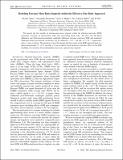Modeling Extreme Mass Ratio Inspirals within the Effective-One-Body Approach
Author(s)
Yunes, Nicolas; Buonanno, Alessandra; Miller, M. Coleman; Pan, Yi; Hughes, Scott A
DownloadHughes_Modeling extreme.pdf (330.4Kb)
PUBLISHER_POLICY
Publisher Policy
Article is made available in accordance with the publisher's policy and may be subject to US copyright law. Please refer to the publisher's site for terms of use.
Terms of use
Metadata
Show full item recordAbstract
We present the first models of extreme-mass-ratio inspirals within the effective-one-body (EOB) formalism, focusing on quasicircular orbits into nonrotating black holes. We show that the phase difference and (Newtonian-normalized) amplitude difference between analytical EOB and numerical Teukolsky-based gravitational waveforms can be reduced to ≲10-1 [10 superscript -1] rad and ≲2×10-3 [10 superscript -3], respectively, after a 2-year evolution. The inclusion of post-Newtonian self-force terms in the EOB approach leads to a phase disagreement of ∼6–27 rad after a 2-year evolution. Such inclusion could also allow for the EOB modeling of waveforms from intermediate-mass-ratio, quasicircular inspirals.
Description
Our database says this has been deposited already, but I couldn't find it in DSpace, so I went ahead.
Date issued
2010-03Department
Massachusetts Institute of Technology. Department of Physics; MIT Kavli Institute for Astrophysics and Space ResearchJournal
Physical review letters
Publisher
American Physical Society
Citation
Yunes, Nicolás et al. “Modeling Extreme Mass Ratio Inspirals within the Effective-One-Body Approach.” Physical Review Letters 104.9 (2010): n. pag. © 2010 The American Physical Society
Version: Final published version
ISSN
0031-9007